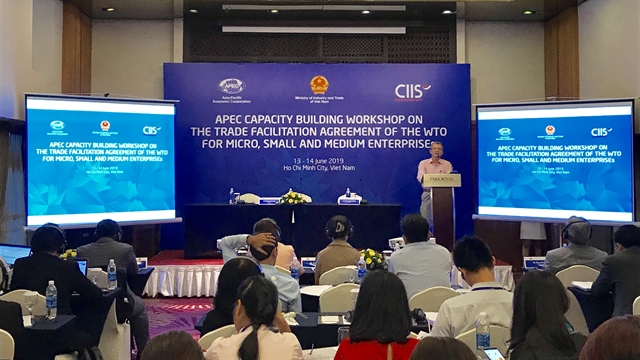 Economy
Economy


|
| Speakers at the APEC capacity-building workshop on the Trade Facilitation Agreement of the WTO for micro, small and medium sized enterprises. — VNS Photo Bồ Xuân Hiệp |
HCM CITY — The World Trade Organisation (WTO) Trade Facilitation Agreement (TFA) will help micro, small- and medium-sized enterprises (MSMEs) further diversify exports and expand markets, as well as improve GDP growth in Việt Nam, experts said on June 13 at a seminar held in HCM City.
Representatives from APEC-member economies, including government officials, MSME policy-makers, the private sector, and MSMEs discussed the benefits of the agreement at a two-day APEC capacity-building workshop.
Dr Đinh Duy Khương, a researcher at Bocconi University in Italy, explained that trade facilitation means “simplification, harmonisation and automation of the procedures applied to international trade, particularly the requirements and formalities related to imports and exports, with a view to further expediting the movement, and the release and clearance of goods, including goods in transit.”
Dr Rajan Sudesh Ratna, economic affairs officer at the UN’s Economic and Social Commission for Asia and the Pacific, noted that these procedures are an important issue for the world trading system.
Nguyễn Phạm Như Hạ, of the General Department of Việt Nam Customs’ Customs Control and Supervision Department, said MSMEs played a key role in Việt Nam’s economy, accounting for more than 97 per cent of the country’s total enterprises.
MSMEs contribute 31 per cent to the country’s GDP, 33 per cent to the national revenue, and generate 62 per cent jobs for employees, she said. “However, MSMEs are small scale with less capital, with a lack of financial and marketing support.”
Other challenges include limited access to law, regulations related to imports and exports, and lack of knowledge of procedures, including declaration, classification, valuation, rule of origin and others.
Conway Beddie, principal assistant director of Multilateral Trade Policy and Negotiation Division at the Malaysian Ministry of International Trade and Industry, said that challenges faced by MSMEs included access to finance, technology, innovation and R&D, highly skilled labour and red tape.
TFA benefits
Beddie said the TFA would benefit MSMEs by reducing trade costs, including simplification and standardisation of customs procedures. It would also expedite movement, release and clearance of goods, and reduce red tape.
Other benefits include access to transparent information as well as opportunities to participate in the policy-making process.
Dr Mohammad Saeed, senior advisor of Trade Facilitation and Policy for Business at the International Trade Centre, said the five main types of trade costs included tariffs, standards, documentation, border costs and logistics costs.
Inefficiency-related trade costs were a particularly stringent and unpredictable problem, which applied to all products, both imports and exports, he said, adding that firms from developing countries were more affected.
Logistics costs are higher in developing countries (26 per cent compared to 14 per cent in more developed countries).
“MSMEs are particularly vulnerable to border inefficiencies. Regulatory burdens hit MSMEs twice as hard as larger firms,” he said. “Removing supply chain barriers has a larger effect than removing tariffs.”
The TFA, which took effect in 2017, seeks to expedite the movement, release and clearance of goods across borders globally.
It opens a new phase for trade facilitation reform worldwide and creates a significant boost for commerce and the multilateral trading system as a whole.
Implementation of the TFA is expected to cut members’ trade costs by an average of 14.3 per cent, with developing countries having the most to gain, according to a study conducted in 2015 by economists from WTO.
The TFA is also likely to reduce the time needed to import goods by over a day and a half and to export goods by almost two days, representing a reduction of 47 per cent and 91 per cent, respectively, over the current average.
Implementing the TFA is also expected to help new firms export for the first time.
In addition, once the TFA is fully implemented, developing countries are expected to increase the number of new products exported by as much as 20 per cent, with the least developed countries likely to see an increase of up to 35 per cent, according to the WTO study.
The agreement allows developing and least-developed countries to set their own timetables for implementing the TFA depending on their capacities.
A trade facilitation agreement facility was created at the request of developing and least-developed countries to help ensure they receive the assistance needed to reap the full benefits of the TFA.
Developed countries have committed to immediately implement the agreement, which sets out a broad series of trade facilitation reforms. With 12 articles, the TFA prescribes measures to improve transparency and predictability of trading across borders and to create a less discriminatory business environment.
The TFA’s provisions include reduced fees and formalities connected with the import/export of goods, faster clearance procedures and enhanced conditions for freedom of transit for goods.
The agreement also contains measures for effective cooperation between customs and other authorities on customs compliance.
The workshop was organised by the Ministry of Industry and Trade, APEC Secretariat, Institute for Development Studies and HCM City International Integration Support Centre. — VNS